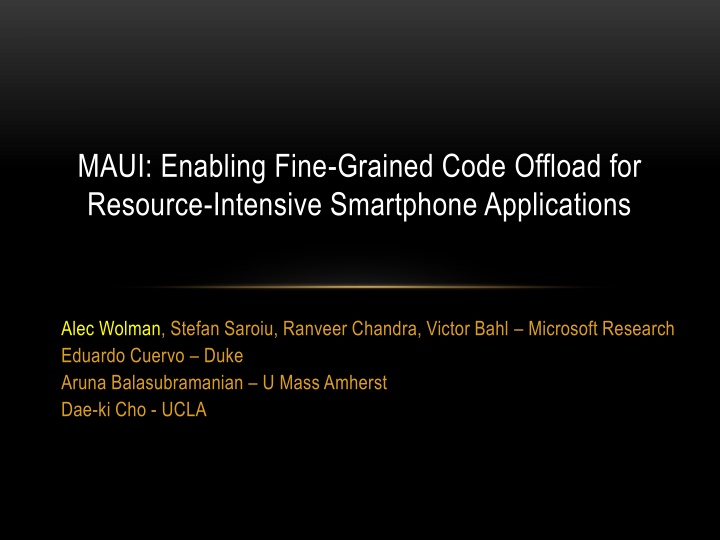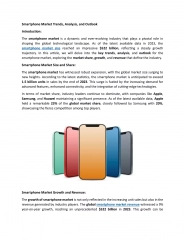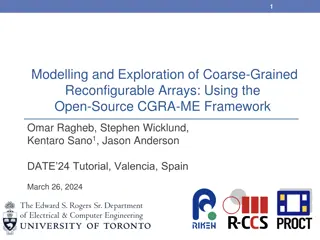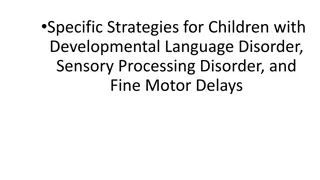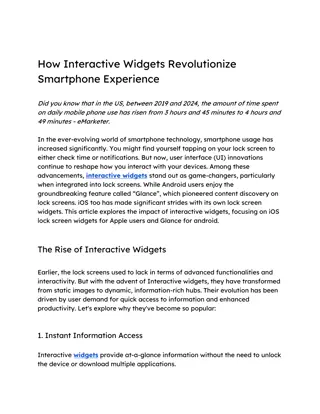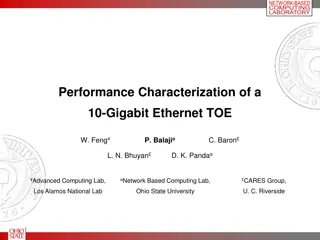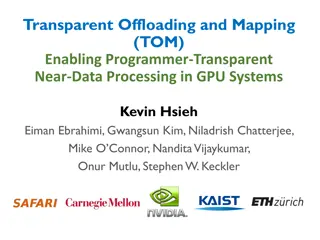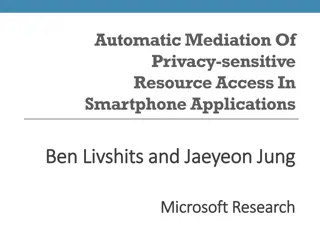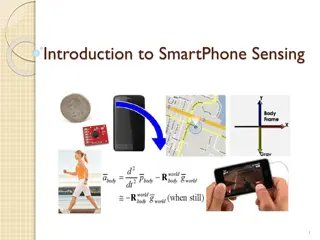MAUI: Enabling Fine-Grained Code Offload for Resource-Intensive Smartphone Applications
MAUI (Mobile offload code with fine-grained control) facilitates computational offload for smartphone applications, offering an alternative to VM-based techniques. With a modern language runtime, MAUI enables fine-grained offload by identifying code and data within running programs for migration to servers. This architecture includes a proxy system that manages control and data transfer, supporting method-level offload decisions at runtime. Language run-time support ensures portability between mobile devices and servers using different instruction sets. Developers can easily incorporate MAUI by adding .NET attributes to indicate offload suitability, helping in energy conservation and performance optimization.
Download Presentation

Please find below an Image/Link to download the presentation.
The content on the website is provided AS IS for your information and personal use only. It may not be sold, licensed, or shared on other websites without obtaining consent from the author.If you encounter any issues during the download, it is possible that the publisher has removed the file from their server.
You are allowed to download the files provided on this website for personal or commercial use, subject to the condition that they are used lawfully. All files are the property of their respective owners.
The content on the website is provided AS IS for your information and personal use only. It may not be sold, licensed, or shared on other websites without obtaining consent from the author.
E N D
Presentation Transcript
MAUI: Enabling Fine-Grained Code Offload for Resource-Intensive Smartphone Applications Alec Wolman, Stefan Saroiu, Ranveer Chandra, Victor Bahl Microsoft Research Eduardo Cuervo Duke Aruna Balasubramanian U Mass Amherst Dae-ki Cho - UCLA
Enabling Fine-Grained Code Offload Cloudlets & CloneCloud propose VM-based techniques to enable computational offload for mobile handhelds [Satya et al., IEEE Pervasive Computing 2009] [Chun et al., HotOS 2009] MAUI leverages a modern language runtime to enable fine-grained offload, an alternative to VM-based approaches
Application Partitioning Partitioned Application (Client-Side) Partitioned Application (Server-Side) Smartphone Application Identify code and data within running program to migrate to server
MAUI Architecture MAUI Runtime MAUI Runtime Server Proxy Client Proxy Application RPC Application Profiler Profiler Solver Solver MAUI Controller Smartphone MAUI Server
How Does a Programmer Use MAUI? Goal: make it dead-simple for developer to MAUI-ify their application Programmer builds a standalone phone app Programmer adds .NET attributes to indicate remoteable Remoteable indicates safe to offload, not should be offloaded MAUI decides at runtime whether to offload, to save energy
MAUI Proxy: Handles Control and Data Transfer MAUI supports fine-grained offload at the method-level At compile time: Find [remoteable] methods Produce client- and server-side stubs for all remoteable methods At run time: Decide whether to invoke local or remote method Perform state synchronization when control transfers (in either direction) Identify what program state to transfer Serialize (deep copy): method parameters, class member variables, public static members Use deltas to reduce the data transfer overhead
Language Run-Time Support For Partitioning Portability: Mobile devices (mostly) use ARM instruction set, servers typically use x86 instructions. .NET Framework uses CIL a language independent byte code that is dynamically compiled to the CPU instruction set Type-Safety: Automate state extraction: need run-time type info to follow pointers Reflection: programmatic inspection of the appication binaries Can identify methods with the [remoteable] tag, without parsing the source code Can extract type signatures of remoteable methods, to automate generating RPC stubs
Evaluation of Fine-Grained Partitioning How does MAUI adapt to changes in program behavior and network conditions? We evaluate this using an Arcade game ported to MAUI, using an off-the-shelf physics engine Scenario 1: no missiles, shortly after initialization Scenario 2: 5 missiles, well into the game
Arcade Game Offload Behavior Scenario 1: RTT > 10 ms Scenario 1: RTT < 10 ms Scenario 2: RTT < 30 ms Scenario 2: 30 ms < RTT < 60 ms HandleEnemies HandleEnemies 11KB + (60 * # missiles) DoLevel DoLevel DoFrame HandleBonuses HandleBonuses 11KB + (60 * # missiles) 60 * # missiles HandleMissiles HandleMissiles Filled oval indicates an offloaded method
Conclusion MAUI uses language runtime support from .NET framework to enable fine-grained code offload Dynamic compilation, type-safety, reflection There is much more to MAUI See our MobiSys 2010 paper for the rest
MAUI Profiler and Solver Profiler produces annotated call graph Vertex: method annotated with computation energy and delay for execution Edge: method invocation annotated with total state transferred R L C L R L R L L 10KB B A R L R L L 45mJ, 30 ms R D L Solver identifies islands in the call graph, where: Energy cost of data transfer < CPU energy saved w/remote execution
How expensive is online profiling? Expensive part of profiling is estimating size of state transfer
How much can MAUI reduce energy consumption (and improve perf)? 35 Smartphone only MAUI (Wi-Fi, 10ms RTT) MAUI (Wi-Fi, 25ms RTT) MAUI (Wi-Fi, 50ms RTT) MAUI (Wi-Fi, 100ms RTT) MAUI* (3G, 220ms RTT) 30 25 Energy (Joules) 20 15 10 5 0 For face recognizer, energy consumption reduced by an order of magnitude
Arcade Game Energy Savings 60 Legend (L to R): Smartphone Only 10 ms, Wi-Fi 25 ms, Wi-Fi 50 ms, Wi-Fi 100 ms, Wi-Fi 220 ms, 3G* 40 Energy (Joules) 20 0 Latency to server impacts the opportunities for fine-grained offload
MAUI Offload Scenarios WLANs are key to effective fine-grained offload High bandwidth, low latency to MAUI servers, energy efficient Offload to the cloud, over 3G: high latency, congestion Enterprise: shared, trusted servers Co-locate MAUI servers with WLAN switches Home: use Wi-Fi to reach trusted desktop PC Public places: Near term: offload to cloud, long latencies Long term: offload to nearby infrastructure (HotSpots)
Why Not Use Static Partitioning? Failure model: when phone is disconnected, or even intermittently connected, applications don t work Developers need to revisit application structure as device characteristics change The portion of an app that makes sense to download changes based on the latency to the MAUI server
Why is the [remoteable] tag necessary? External side-effects (e.g. purchase an item from the Web): Need to understand if a sequence of I/O calls is undoable This is a very hard problem, unlikely to be addressed with static analysis Limitations of our current implementation: Need to classify calls into .NET Framework built-in APIs as local or remote Internal side-effects: Handling multi-threaded apps & async I/O In the long term, static program analysis should be able to address these limitations
MAUI Partitioning Limitations Failure model: lose contact with server, re-execute from last sync point Limited support for multi-threaded programs & async I/O Methods with external side effects cannot be offloaded E.g. Buying a book from Amazon
Enable Resource-Intensive Apps Augmented Reality Example: Help a person with memory loss Corrective Human Behavior Example : Immediate fact corrections during a speech Mobile Gaming Healthcare Offload analysis of sensed data from body-worn sensors Low end-to-end latency critical for interactive apps These energy-intensive tasks can rapidly drain the battery
